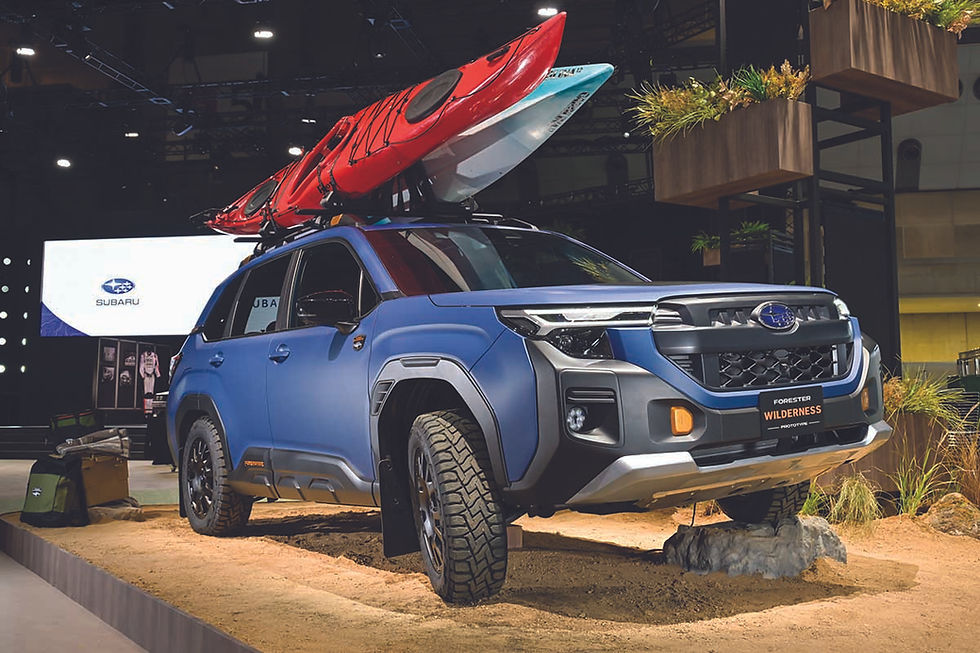Is Qashqai the car of the future?
- Gary Worrall
- Sep 8
- 3 min read

LIKE them or not, thanks to government regulation, electric and hybrid vehicles are here to stay, with manufacturers facing ever-tighter rules on what can be sold in Australia.
Nissan met the rules head-on, and developed what is possibly the best solution for Australia, with the e-Power QASHQAI, an electric vehicle with an on-board generator.
The revised QASHQAI is a funky looking small medium SUV, combining a sharply angled and sloped trapezoidal front with a traditional curved roof cabin and rear section into an easily recognised profile, aiding carpark visibility.
While the ridged door and bonnet lines give an aggressively aerodynamic appearance, pushing air over the 3-D prism-style door pressings, the turret section, above the doors, narrows noticeably, reducing passenger shoulder room.
Our test car was the top spec N-Design version, with all the fruit, including leather/alcantara trimmed, power-adjustable, front seats, dash, door trims and centre console knee pads, 10-speaker BOSE audio system and a motion-sensing, powered, tailgate.

Despite the panoramic glass roof, there is plenty of headroom, the narrowed turret can have you bumping the B-Pillar trims, but leg room is good, even for tall drivers, the general position is good, with multi-adjustable steering column and variable height seatbelts.
While well-padded, the thigh bolsters narrow the seat base, bigger drivers will sit on them, but they remain comfortable, even on long journeys, especially using the three-function massage option.
The driving position is cockpit-like, with a mouse-style gear selector in the flat centre console, the flattish-bottomed steering wheel is thickly padded, with thumb buttons for audio, cruise and display functions.
Regardless of the steering column height setting, the multi-colour instrument cluster is easy to read, aided by the floating Heads Up Display projected onto the windscreen, the driver gets speed and navigation information without looking away from the road.
Luggage space was reasonable, the tailgate opens high, tall users don’t feel crowded, loading the weekly groceries was a simple chore, although bulky items will fill the area quickly.
Driving the e-Power is a simple, yet intriguing, task, a start button brings the system to life silently, like other EVs, engage Drive, release the park brake and the N-Design glides away, with a decent kick from the 140kW/330Nm electric driveline.
The petrol engine is a generator only, charging the batteries as well as providing power to the electric motor, with no direct link to the driveline.
Under heavy acceleration, or if the battery is low on charge, the petrol engine works to the driver’s throttle inputs, the harder you push, the more it revs, giving the feel it is driving the car, despite no direct link to the driveline.
The e-Power unit can be locked in EV mode for silent running, or if you are in a low- or zero-emission zone, using battery power and regenerative braking only, the petrol motor restarting after exiting EV mode.
There is no transmission, with direct drive from the electric motor to the front wheels, the harder you push the throttle, the faster you go, using e-Pedal mode negates the use of the brake, push the throttle to go, release it to brake.
It takes getting used to, but maximising energy capture by regenerative braking extends the period between using engine power, improving fuel economy, especially in stop-start traffic.
Otherwise, the N-Design drives ‘normally’, while the 20” rims and low profile tyres stiffen the ride, the suspension is relaxed without being overly soft, with responsive steering and predictable handling, even with the elevated SUV-style ride height.
The e-Power driveline’s big advantage is being an EV for low emissions, the onboard generator eliminates ‘range anxiety’, never needing to be plugged in to charge, you drive until the tank is empty, so long as there is fuel, the car can be driven.
With recharging infrastructure playing catch-up, especially in regional areas, this is a huge boost for potential EV owners, removing the concern of being stranded with no power, still a genuine worry for drivers without access to a charge point on their journey.




Comments